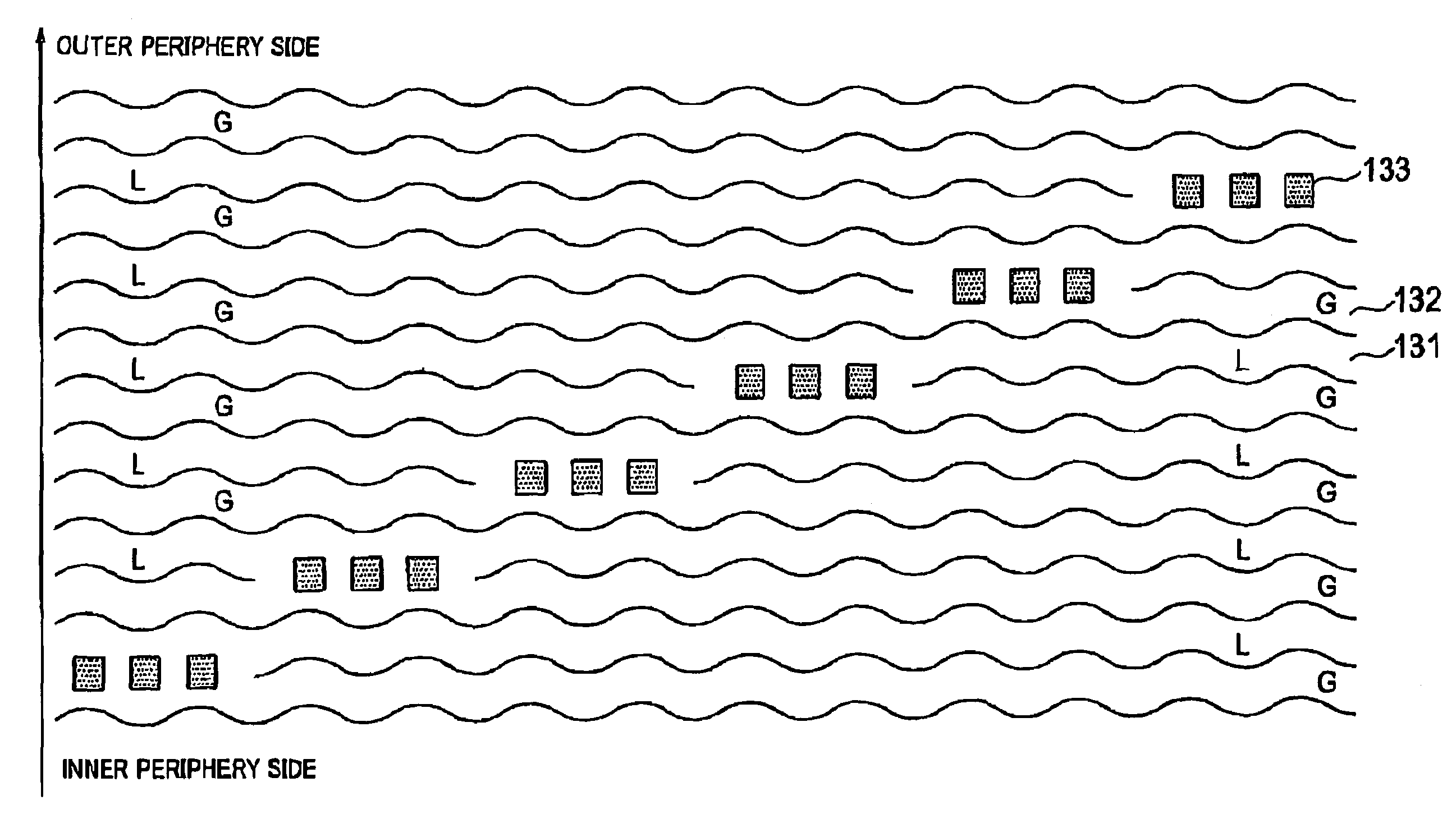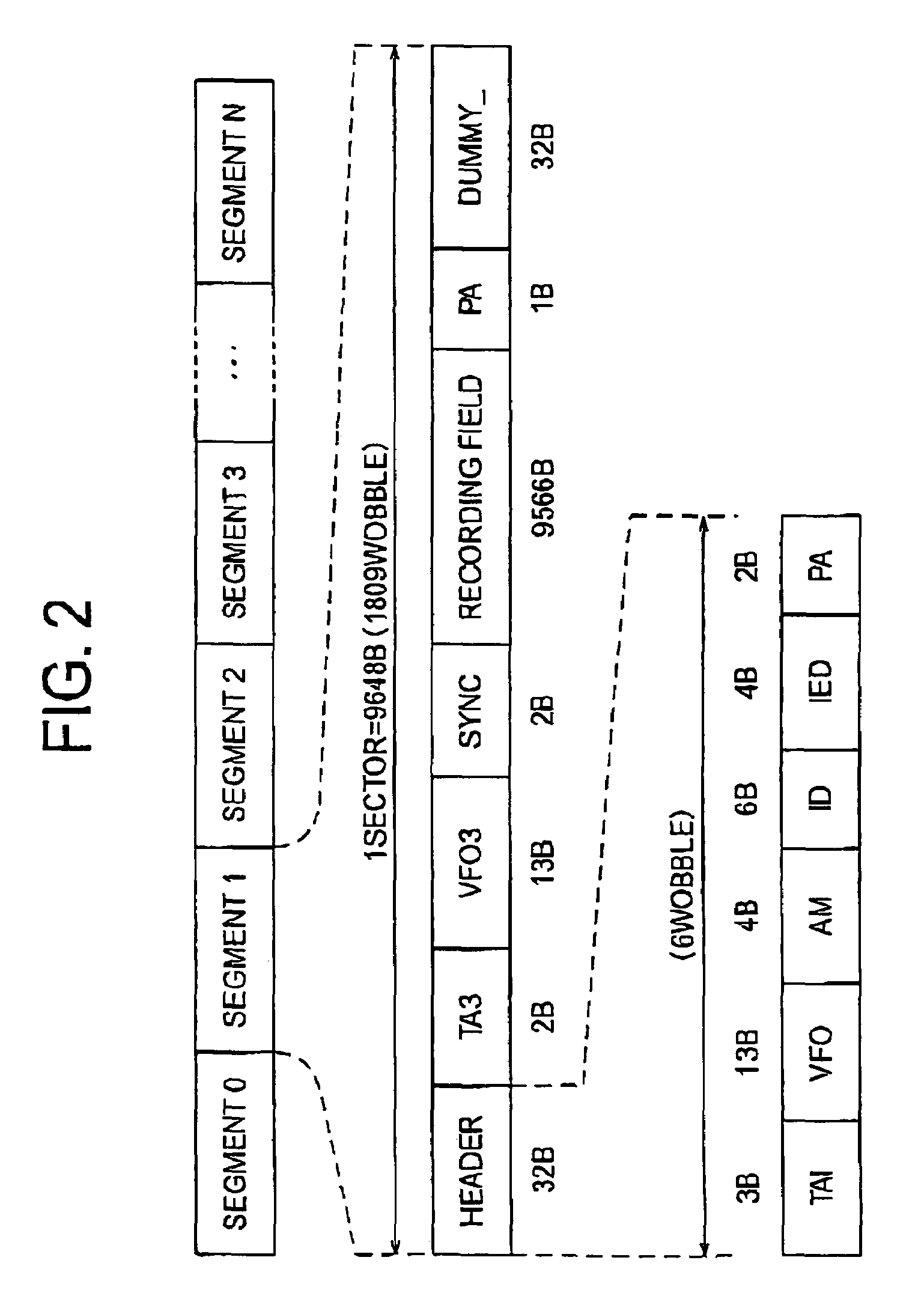Optical disc and recording/producing method therefor
a technology of optical discs and recording/producing methods, applied in the field of optical disc formatting, can solve the problems of increasing data reproduction errors, clock signals may not be extracted, and it is difficult to design a multi-layer recordable optical disc, so as to reduce the crosstalk between the signal light beam from the header area and the signal light beam from the recording-data area
- Summary
- Abstract
- Description
- Claims
- Application Information
AI Technical Summary
Benefits of technology
Problems solved by technology
Method used
Image
Examples
first embodiment
[0064]FIG. 1 shows the surface configuration of the recording layer 10, which is one of the two recording layers of an optical disc according to this embodiment, and lies near the light source of an optical head. The wobbles shown in FIG. 1. i.e., meandering lines, are schematic ones. The number of the wobbles is not equal to the number of waves, which will be described later.
[0065]As FIG. 1 depicts, the header areas are arranged between the data-recording areas and equally spaced from one another in the scanning direction of the light beam in the data-recording areas, that is, in the circumferential direction of the optical disc. The data-recording areas including land areas 131 (i.e., areas L), which are convex portions of the optical disc, and adjacent groove areas 132 (i.e., areas G), which are concave portions. Further, prepit areas are located each on an every other boundary between a land area L and a groove area G. Each prepit area includes prepits 133 that represent physica...
second embodiment
[0069]In an optical disc according to this embodiment, the change of the Hal generated from the light reflected by the recording layer near the light-incident side is at most 10% of the amplitude of the signal generated from the light reflected by We recorded mark / space which includes trains of prepits and which is provided on the other recording layer on which a light beam is focused.
[0070]For example, when a light beam is focused on the recording layer 20 to record or reproduce data, the beam passing the recording layer 10 has a diameter of about 44 μm, as described above. The light beam reflected from the recording layer 10 including the header areas irradiated by the beam spot is superposed on the light beam reflected from the recording layer 20. The light-receiving element incorporated in the optical head receives both light beams, superposed one on the other.
[0071]As described before in the problems with the prior art, the data reproduced cannot be correctly identified if the ...
third embodiment
[0076]In an optical disc according to this embodiment, the groove areas wobble at a frequency that is an integral multiple of the channel-clock frequency and are aligned, in each zone, in the radial direction of the disc.
[0077]As FIG. 1 shows, the groove areas may be formed in each zone by the intra-zone CAM system and may therefore wobble, forming wobbles, at a frequency that is an integral multiple of the channel-clock frequency. In this case, the wobbles will be aligned in the radial direction of the disc. In a two-layer optical disc, for example, the inter-layer crosstalk developing when data is recorded / reproduced on the recording layer 20 causes only a negligibly small interference even if the groove areas wobble on the recording layer 10 at a prescribed frequency.
[0078]The wobbles formed are aligned in the radial direction of the disc. As a result, wobble signals that have no distortion like the signals reproduced from the groove areas are detected in the land areas. A desira...
PUM
| Property | Measurement | Unit |
|---|---|---|
| distance | aaaaa | aaaaa |
| refractive index | aaaaa | aaaaa |
| refractive index | aaaaa | aaaaa |
Abstract
Description
Claims
Application Information
 Login to View More
Login to View More - R&D
- Intellectual Property
- Life Sciences
- Materials
- Tech Scout
- Unparalleled Data Quality
- Higher Quality Content
- 60% Fewer Hallucinations
Browse by: Latest US Patents, China's latest patents, Technical Efficacy Thesaurus, Application Domain, Technology Topic, Popular Technical Reports.
© 2025 PatSnap. All rights reserved.Legal|Privacy policy|Modern Slavery Act Transparency Statement|Sitemap|About US| Contact US: help@patsnap.com



